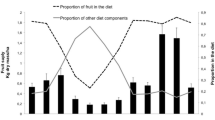Abstract
Quantification of fruit fall is the only way to compare fruit food availability among different studies. This study aims to reveal the general characteristics of fruit fall in temperate forests, which should offer indispensable information for using fruit fall data as food availability for frugivores. Fruit fall in three warm-temperate and two cool-temperate forests on Yakushima, an island in southwestern Japan, were studied for two years in one cool-temperate plot of 50 m × 50 m in size and for four years in other plots of 100 m × 50 m in size. The elevations of the plots ranged 170–1200 m a.s.l. Fruit fall was highest in the lowland forests (599 and 564 DW kg·ha−1·year−1 and lowest in the mid-elevation forest (198 DW kg·ha−1·year−1). Fleshy fruits and food-fruits for Japanese macaques constituted 3–37% and 4–87% of the total fruit fall, respectively. When only fleshy-fruit fall was compared, it was higher in the western lowland forest (222 DW kg·ha−1·year−1) than in any other forests (9–66 DW kg·ha−1·year−1). The pulp of fleshy fruits, presumably the edible parts for frugivores, was only 1.1–12.7% of the total fruit fall. The edible parts for Japanese macaques constituted 3–54% of the fruit fall, showing a high value where acorns are abundant. Half of the fruit-fall biomass consisted of only one or two nonfleshy-fruited species, which are usually dominant in many other temperate forests, such as Quercus and conifers. These variations agreed with the variations in occurrence of frugivorous (such as Japanese macaques).
Similar content being viewed by others
References
Aiba S, Hanya G, Tsujino R, Takyu M, Seino T, Kimura K, Kitayama K. 2007. Comparative study of additive basal area of conifers in forest ecosystems along elevational gradients. Ecol Res, 22: 439–450
Ajbilou R, Maranon T, Arroyo J. 2006. Ecological and biogeographical analyses of Mediterranean forests of northern Morocco. Acta Oecol, 29: 104–113
Chapman C A, Wrangham R, Chapman L J. 1994. Indexes of habitat-wide fruit abundance in tropical forests. Biotropica, 26: 160–171
Eguchi T. 1984. Climate of Yaku-shima Island, especially regionality of precipitation distribution. In: Nature Conservation Bureau E A, Japan, ed. Conservation Reports of the Yaku-shima Wilderness Area, Kyushu, Japan. Tokyo: Environment Agency, 3–26
Furuno T. 1986. Investigation on productivity of Japanese fir (Abies firma Sieb. et Zucc) and hemlock (Tsuga sieboldii Carr.) stands in Kyoto University forest in Wakayama: (VIII) Litter-fall and its fluctuations in the mixed fir and hemlock stand over years. Bull Kyoto Univ For, 58: 35–50
Ganesh T, Davidar P. 1999. Fruit biomass and relative abundance of frugivores in a rain forest of southern Western Ghats, India. J Trop Ecol, 15: 399–413
Hanya G. 2004. Diet of a Japanese macaque troop in the coniferous forest of Yakushima. Int J Primatol, 25: 55–71
Hanya G, Kiyono M, Yamada A, Suzuki K, Furukawa M, Yoshida Y, Chijiiwa A. 2006. Not only annual food abundance but also fallback food quality determines the Japanese macaque density: evidence from seasonal variations in home range size. Primates, 47: 275–278
Hanya G, Noma N, Agetsuma N. 2003. Altitudinal and seasonal variations in the diet of Japanese macaques in Yakushima. Primates, 44: 51–59
Hanya G, Yoshihiro S, Zamma K, Matsubara H, Ohtake M, Kubo R, Noma N, Agetsuma N, Takahata Y. 2004. Environmental determinants of the altitudinal variations in relative group densities of Japanese macaques on Yakushima. Ecol Res, 19: 485–493
Hendrick R L. 2001. Forest types and classification. In: Evans J, ed. The Forest Handbook volume 1: An Overview of Forest Science. Oxford: Springer, 23–64
Kissling W D, Rahbek C, Bohning-Graese K. 2007. Food plant diversity as broad-scale determinant of avian frugivore richness. Proc R Soc B-Biol Sci, 274: 799–808
Morellato L P C. 1992. Nutrient cycling in 2 south-east Brazilian forests .1. litterfall and litter standing crop. J Trop Ecol, 8: 205–215
Noma N, Yumoto T. 1997. Fruiting phenology of animal-dispersed plants in response to winter migration of frugivores in a warm temperate forest on Yakushima Island, Japan. Ecol Res, 12: 119–129
Saito H. 1993. Periodicity of annual yield of reproductive organs in a Castanopsis cuspidata stand over eight years. Sci Rep Kyoto Pref Univ (Agr), 45: 1–18
Stevenson P R. 2001. The relationship between fruit production and primate abundance in Neotropical communities. Biol J Linnean Soc, 72: 161–178
Tagawa H. 1980. Vegetation on the western slope of Mt. Kuniwaridake, Yakushima Island. Sci Rep Kagoshima Univ, 29: 121–137
Takyu M, Kubota Y, Aiba S, Seino T, Nishimura T. 2005. Pattern of changes in species diversity, structure and dynamics of forest ecosystems along latitudinal gradients in East Asia. Ecol Res, 20: 287–296
White L J T. 1994. Patterns of fruit fall phenology in the Lopé Reserve, Gabon. J Trop Ecol, 10: 289–312
Willson M F, Irvine A K, Walsh N G. 1989. Vertebrate dispersal syndromes in some Australian and New Zealand plant communities, with geographic comparisons. Biotropica, 21: 133–147
Wright S J, Carrasco C, Calderón O, Paton S. 1999. The El Niño Southern Oscillation variable fruit production, and famine in a tropical forest. Ecology, 80: 1632–1647
Yoshihiro S, Ohtake M, Matsubara H, Zamma K, Hanya G, Tanimura Y, Kubota H, Kubo R, Arakane T, Hirata T, Furukawa M, Sato A, Takahata Y. 1999. Vertical distribution of wild Yakushima macaques (Macaca fuscata yakui) in the western area of Yakushima Island, Japan: Preliminary report. Primates, 40: 409–415
Yoshihiro S, Ohtake M, Zamma K, Hanya G, Matsubara H, Tanimura Y, Kubo R, Matsushima K, Hayakawa S, Kojima T, Hirano A, Takahata Y. 1998. The distribution and fecal analysis of Yakushima macaques on the coniferous forest. Primate Res, 14: 189–199
Author information
Authors and Affiliations
Corresponding author
Rights and permissions
About this article
Cite this article
Hanya, G., Aiba, Si. Fruit fall in five warm- and cool-temperate forests in Yakushima, Japan. For. Stud. China 12, 184–192 (2010). https://doi.org/10.1007/s11632-010-0403-9
Received:
Accepted:
Published:
Issue Date:
DOI: https://doi.org/10.1007/s11632-010-0403-9




